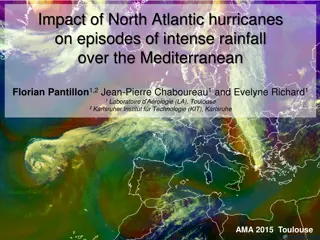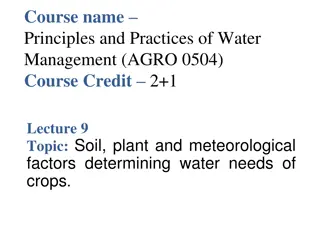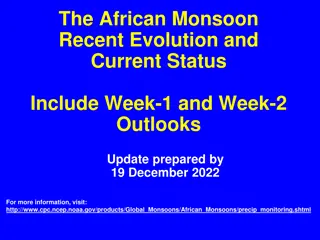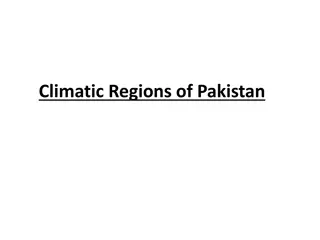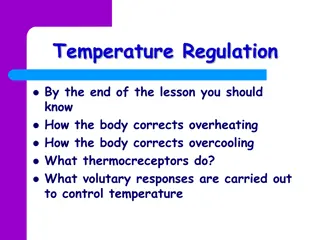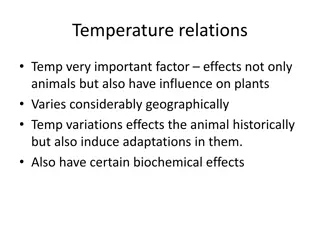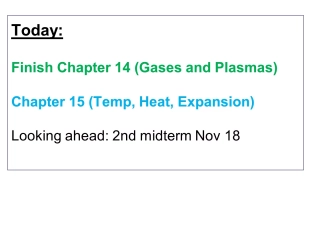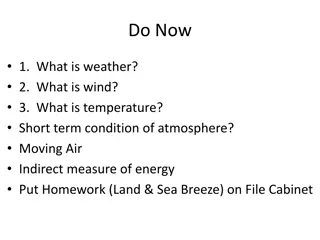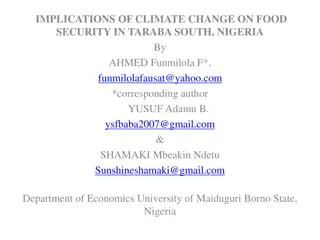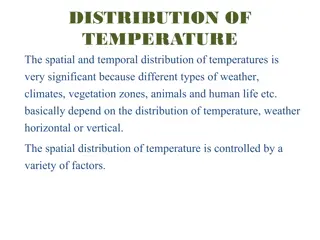Factors Influencing Temperature and Rainfall in Geography Lessons
Factors such as distance from the equator, sea, altitude, ocean currents, winds, and mountains influence temperature and rainfall patterns. Understanding these factors is crucial for geography students to grasp the concepts of climate and weather conditions in different regions. The provided notes emphasize the importance of geographical features on local climates and precipitation levels, guiding learners on how to observe and analyze these elements in their studies.
Download Presentation

Please find below an Image/Link to download the presentation.
The content on the website is provided AS IS for your information and personal use only. It may not be sold, licensed, or shared on other websites without obtaining consent from the author. Download presentation by click this link. If you encounter any issues during the download, it is possible that the publisher has removed the file from their server.
E N D
Presentation Transcript
GRADE 8 GEOGRAPHY Unit 1: Factors influencing temperature & rainfall Good day learners and parents/guardians/caregivers RE: WORK FOR DURATION OF LOCKDOWN Please view the PowerPoint/document. These are notes that learners must write into their workbooks or they can Print and Paste it into their books. This is of utmost importance as the content covered in these notes will be the work that gets examined at the end of the term.
I would suggest that the learners spends a maximum of 2 hours per week on the subject which would sufficiently cover the class time that is being lost. For example, Tuesday and Thursday, one hour each day. Please first read through the content covered in the textbook at least twice. (Pgs 78 81). Then read through the notes/summary and make sure that it is written or pasted in your notebooks. Complete Activity 1 pg. 81 (Unit 2 will be available on Wednesday.)
Factors influencing temperature and rainfall 1.1 Distance from the equator (latitude) 1.2 Distance from the sea 1.3 Height above sea level (altitude) 1.4 Ocean currents and winds 1.5 Mountains (relief)
1.1. Distance from the Equator (Latitude) Rainfall Temperature Cooler/Colder temperatures are found near the poles (North and South Poles). In polar areas we can expect snowfall because the air is colder and descends. Hot temperatures are found near the equator. Because it is warmer around the equator, we can expect more rainfall here. Hot and cool temperatures are found near the Tropics.
1.2. Distance from the Sea Inland areas are Hotter in Summer and Colder in Winter; and receive LESS rainfall due to the distance travelled from the sea. SEA Temperature changes at a slower rate than LAND temperature; therefore coastal areas will have milder winters & cooler summers.
1.3. Height above sea level (Altitude) Temperature: The higher you go, the colder it becomes because air temperature depends on air density. Air at higher altitudes: less dense and colder (convection) Air at lower altitudes: more dense and warmer (conduction) Rainfall: The higher the altitude, the cooler it becomes, therefore cooling moisture condenses and forms rain droplets. Mountain areas receive more rainfall than flat or lower areas.
1.4. Ocean Currents and Winds COLD BENGUELA CURRENT (from the Poles) cools down the WEST COAST of South Africa WARM AGULHAS CURRENT (from the Tropics & Equator) warms up the EAST COAST of South Africa LESS rainfall along the WEST COAST of South Africa due to the COLD current. MORE rainfall along the EAST COAST of South Africa due to the WARM current.
Warmer slopes have higher temperatures so they receive more rain. 1.5. Mountains The closer the slopes are to the equator, the warmer they are. The closer the slopes are to the poles, the colder they are. Leeward slopes (facing away from the equator) have less rainfall. Slopes close to the poles have snowfall.



